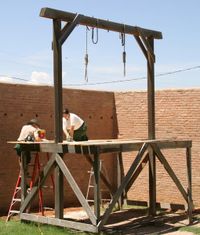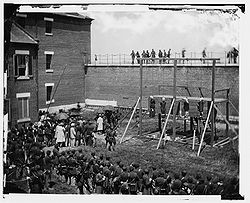
Gallows
Encyclopedia

Hanging
Hanging is the lethal suspension of a person by a ligature. The Oxford English Dictionary states that hanging in this sense is "specifically to put to death by suspension by the neck", though it formerly also referred to crucifixion and death by impalement in which the body would remain...
, or by means to torture before execution, as was used when being hanged, drawn and quartered
Hanged, drawn and quartered
To be hanged, drawn and quartered was from 1351 a penalty in England for men convicted of high treason, although the ritual was first recorded during the reigns of King Henry III and his successor, Edward I...
. The gallows took its form from the Roman Furca when Constantine
Pope Constantine
Pope Constantine was pope from 708 to 715. With the exception of Antipope Constantine, he was the only pope to take such a "quintessentially" Eastern name of an emperor...
abolished crucifixion
Crucifixion
Crucifixion is an ancient method of painful execution in which the condemned person is tied or nailed to a large wooden cross and left to hang until dead...
.
Forms of hanging
A gallows can take several forms.- the simplest form (as often used in the game "HangmanHangman (game)Hangman is a paper and pencil guessing game for two or more players. One player thinks of a word and the other tries to guess it by suggesting letters.-Overview:...
") resembles an inverted "L", with a single upright and a horizontal beam to which the ropeRopeA rope is a length of fibres, twisted or braided together to improve strength for pulling and connecting. It has tensile strength but is too flexible to provide compressive strength...
nooseNooseA noose is a loop at the end of a rope in which the knot slides to make the loop collapsible. Knots used for making nooses include the running bowline, the tarbuck knot, and the slip knot.-Use in hanging:...
would be attached. - the horizontal crossbeam is supported at both ends.
- temporary gallows.
- the infamous Tyburn gallows was triangular in plan, with three uprights and three crossbeams, allowing up to 24 men and women to be executed simultaneously when all three sides were used.
Occasionally, an improvised gallows is used, usually by hanging the condemned from a tree or street light
Street light
A street light, lamppost, street lamp, light standard, or lamp standard is a raised source of light on the edge of a road or walkway, which is turned on or lit at a certain time every night. Modern lamps may also have light-sensitive photocells to turn them on at dusk, off at dawn, or activate...
. Hangings from such improvised gallows are usually lynchings rather than judicial executions.
Types

Permanent
Gallows may be permanent to act as a deterrent and grim symbol of the power of high justiceHigh Justice
High Justice is a 1974 collection of science fiction short stories by Jerry Pournelle. It was republished in a omnibus edition with Exiles to Glory in 2009 as Exile -- and Glory....
(the French word for gallows, potence, stems from the Latin word potentia, meaning "power"). Many old prints of European cities show such a permanent gallows erected on a prominent hill outside the walls, or more commonly near the castle or other seat of justice. In the modern era the gallows were often installed inside a prison; freestanding on a scaffold in the yard, erected at ground level over a pit, enclosed in a small shed of stone, brick or wood, built into the gallery of a prison wing (with beam in brackets
Bracket (architecture)
A bracket is an architectural member made of wood, stone, or metal that overhangs a wall to support or carry weight. It may also support a statue, the spring of an arch, a beam, or a shelf. Brackets are often in the form of scrolls, and can be carved, cast, or molded. They can be entirely...
on opposite walls), or in a purpose-built execution suite of rooms within the wing and close to the condemned cell.
Temporary
Gallows can also be temporary. In some of the cases, they were even moved to the location of the crime. In England, pirates were typically executed using a temporary gallows, at low tide in the Intertidal zoneIntertidal zone
The intertidal zone is the area that is above water at low tide and under water at high tide . This area can include many different types of habitats, with many types of animals like starfish, sea urchins, and some species of coral...
, then left for the sea to wash over them during three following high tides.
The only surviving New Drop gallows in the UK are in Rutland County Museum
Rutland County Museum
Rutland County Museum is located in Oakham, Rutland, in the old Riding School of the Rutland Fencible Cavalry which was built in 1794-95. The museum, opened in 1969, houses a collection of objects relating to local rural and agricultural life, social history and archaeology. Temporary exhibitions...
. The gallows were portable and were set up at the Gaol when needed. These gallows were first used in 1813 to hang two burglars. The New Drop design was not very effective as the drop was too short to break the neck cleanly.
Portable
If a crime took place inside, e.g., a building, gallows may be erected—and the criminal hanged—at the front door. In some cases of multiple offenders it was not uncommon to erect multiple temporary gallows, with one noose per condemned criminal. In one case a condemned strangled to death in agony for forty minutes until he finally died from asphyxiation.Horse and cart
Hanging people from early gallows sometimes involved fitting the noose around the person's neckNeck
The neck is the part of the body, on many terrestrial or secondarily aquatic vertebrates, that distinguishes the head from the torso or trunk. The adjective signifying "of the neck" is cervical .-Boner anatomy: The cervical spine:The cervical portion of the human spine comprises seven boney...
while he or she was on a ladder or in a horse-drawn cart underneath. Removing the ladder or driving the cart away left the person dangling by the neck to slowly strangle. Later, a "scaffold" with a trap-door tended to be used, so victims dropped down and died quickly from a broken neck rather than through strangulation, especially if extra weights were fixed to their ankles.
During the era of public execution in London
London
London is the capital city of :England and the :United Kingdom, the largest metropolitan area in the United Kingdom, and the largest urban zone in the European Union by most measures. Located on the River Thames, London has been a major settlement for two millennia, its history going back to its...
, England, a prominent gallows stood at Tyburn
Tyburn
Tyburn is a former village just outside the then boundaries of London that was best known as a place of public execution.Tyburn may also refer to:* Tyburn , river and historical water source in London...
, now in the region of Connaught Square
Connaught Square
Connaught Square, in the City of Westminster , was the first square of city houses to be built in the Bayswater area. It was named after the Duke of Gloucester , who had a house nearby. The current appearance of the square dates from the 1820s. The square is just north of Hyde Park, and to the west...
. Later executions occurred outside Newgate Gaol, now the Old Bailey
Old Bailey
The Central Criminal Court in England and Wales, commonly known as the Old Bailey from the street in which it stands, is a court building in central London, one of a number of buildings housing the Crown Court...
.
See also
- Capital punishmentCapital punishmentCapital punishment, the death penalty, or execution is the sentence of death upon a person by the state as a punishment for an offence. Crimes that can result in a death penalty are known as capital crimes or capital offences. The term capital originates from the Latin capitalis, literally...
- Dule TreeDule TreeDule or dool trees in Britain were used as gallows for public hangings. They were also used as gibbets for the display of the corpse for a considerable period of time after such hangings...
- GibbetGibbetA gibbet is a gallows-type structure from which the dead bodies of executed criminals were hung on public display to deter other existing or potential criminals. In earlier times, up to the late 17th century, live gibbeting also took place, in which the criminal was placed alive in a metal cage...
- Hangman's ElmHangman's ElmHangman's Elm, or simply "The Hanging Tree", is an English Elm located at the Northwest corner in Washington Square Park, in the New York City borough of Manhattan...
- Moot hillMoot hillA moot hill or mons placiti is a hill or mound historically used as an assembly or meeting place. In early medieval Britain, such hills were used for "moots", meetings of local people to settle local business. Among other things, proclamations might be read; decisions might be taken; court cases...
External links
- BBC Article about British manufacturer.
- wikibooks:A Researcher's Guide to Local History Terminology: Local History terminology.

